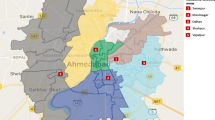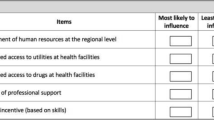Abstract
At present there are no nephrology facilities in Greenland. Greenlandic patients with renal failure needing dialysis thus have to travel to Denmark to obtain treatment. For patients in haemodialysis this necessitates a permanent residence in Denmark. Our study was aimed at examining Greenlanders’ preferences for establishing nephrology facilities in Greenland at Queen Ingrid’s Hospital in Nuuk, and to estimate the associated change in welfare. Preferences were elicited using a discrete choice experiment (DCE). A random sample of 500 individuals of the general population was sent a postal questionnaire in which they were asked to consider the trade-offs of establishing nephrology facilities in Greenland as opposed to the current situation. This involved trading off the benefits of having such facilities in their home country against the costs of the intervention. Besides including a payment attribute described in terms of incremental tax payment, the DCE included two interventions attributes related to (1) the organisation of labour, and (2) the physical settings of the patients. Respondents succeeded in answering the DCE despite cultural and linguistic disparity. We found that all the included attributes had a significant effect on respondents’ choices, and that respondents’ answers to the DCE were in keeping with their values as stated in the questionnaire. DCE data was analyzed using a random parameter logit model reparametrized in willingness-to-pay space. The results showed that establishing facilities in Greenland were preferred to the current treatment in Denmark. The welfare estimate from the DCE, at DKK 18.74 million, exceeds the estimated annual costs of establishing treatment facilities for patients with chronic renal failure. Given the estimated confidence interval this result seems robust. Establishing facilities in Greenland therefore would appear to be welfare-improving, deriving positive net benefits. Despite the relatively narrow policy focus, we believe that our findings provide some insight into individuals’ preferences for decentralization of public services and on citizens’ views of ‘self-governance’ that go beyond the case of Greenland. More generally, this paper illustrates how DCE can be applied successfully to developing countries with culturally, demographically, and geographically distinct features.
Similar content being viewed by others
Notes
Life expectancy in Greenland is 65 years for men and 70 for women.
The block grant from Denmark was 3,100 million DKK in total in 2005. The gross national product (GNP) at market prices was DKK 10,210 million DKK in 2005 whereas the total tax revenue was 4,068 million DKK.
In January 2006, the adult population (age 18+) was 39,963 (Greenland Statistics [2]).
12 respondents did not answer any of the DCE questions. Less than 20 of the questionnaires were answered using telephone interviews.
The need and preferences for better access to treatment stand against problem of recruiting health care personnel. Recruitment and retention of authorized health care personnel is becoming increasingly difficult (Nordic Social-Statistical Committee 2004: http://nososco-eng.nom-nos.dk/default.asp?side=220).
References
Mangham, L.J., Hanson, K., McPake, B.: How to do (or not to do) designing a discrete choice experiment for application in a low-income country. Health Policy Plann. 24(2), 151–158 (2009)
Greenland Statistics; http://www.statgreen.gl
Iburg, K.M., Bronnum-Hansen, H., Bjerregaard, P.: Health expectancy in Greenland. Scand. J. Publ. Health 29(1), 5–12 (2001)
Sundhedsstyrelsen. Dialyse ved kronisk nyresvigt—kan antallet af patienter i udgående dialyse øges? En medicinsk teknologivurdering. Sundhedsstyrelsen, Center for Evaluering og Medicinsk Teknologivurdering, København, 2006 (8)
Dolan, P., Olsen, J.A., Menzel, P., Richardson, J.: An inquiry into the different perspecitves that can be used when elicting preferences in health. Health Econ. 12(7), 545–551 (2003)
Street, D., Burgess, L.: The construction of optimal stated choice experiments: theory and methods. Wiley-Interscience, New Jersey (2007)
Bech, M., Gyrd-Hansen, D.: Effects coding in discrete choice experiments. Health Econ. 14(10), 1079–1083 (2005)
Lancaster, K.J.: A new approach to consumer theory. J Polit Econ 74(2), 132–157 (1966)
McFadden, D.: Conditional logit analysis of qualitative choice behaviour. In: Zarembka, P. (ed.) Frontiers of econometrics, pp. 105–142. Academic, London (1974)
Train, K.: Discrete choice methods with simulation. Cambridge University Press, Cambridge (2003)
Scarpa, R., Thiene, M., Train, K.: Utility in willingness to pay space: a tool to address confounding random scale effects in destination choice to the Alps. Am. J. Agric. Econ. 90(4), 994–1010 (2008)
Train, K., Weeks, M.: Discrete choice models in preference space and willingness-to-pay space. In: Scarpa, R., Alberini, A. (eds.) Applications of simulation methods in environmental and resource economics, pp. 1–17. Springer, Dordrecht (2005)
Bierlaire M. BIOGEME: A free package for the estimation of discrete choice models. Proceedings of the 3rd Swiss Transportation Research Conference, Ascona, Switzerland, 2003
Krinsky, I., Robb, A.L.: Three methods for calculating the statistical properties of elasticities: a comparison. Empir. Econ. 16(2), 199–209 (1991). doi:10.1007/BF01193491
Lancsar, E., Savage, E.: Deriving welfare measures from discrete choice experiments: inconsistency between current methods and random utility and welfare theory. Health Econ. 13(9), 901–907 (2004)
Ryan, M.: Deriving welfare measures in discrete choice experiments: a comment to Lancsar and Savage. Health Econ. 13(9), 909–912 (2004)
Silva, J.M.C.S.: Deriving welfare measures in discrete choice experiments: a comment to Lancsar and Sagage (2). Health Econ. 13(9), 913–918 (2004)
Boardman, A., Greenberg, D., Vining, A., Weimer, D.: Cost-benefit analysis, concepts and practice, 4th edn. Prentice Hall, New York (2010)
Carson, R.T., Groves, T.: Incentive and informational properties of preference questions. Environ. Resour. Econ. 37(1), 181–210 (2007)
Bateman, I.J., Carson, R.T., Day, B., et al.: Economic evaluation with stated preference techniques, a manual, 1st edn. Elgar, Cheltenham (2002)
Dixon, S., Shackley, P.: The use of willingness to pay to assess public preferences toward the fortification of foodstuffs with folic acid: results of a pilot study. Health Expect. 6(2), 140–148 (2003)
Morrison, M.D., Blamey, R.K., Bennett, J.W.: Minimising payment vehicle bias in contingent valuation studies. Environ. Resour. Econ. 16(4), 407–422 (2000)
Johnston, R.J., Swallow, S.K., Weaver, T.F.: Estimating willingness to pay and resource tradeoffs with different payment mechanisms: an evaluation of a funding guarantee for watershed management. J. Environ. Economics Manage 38(1), 97–120 (1999)
Lusk, J.L., McLaughlin, L., Jaeger, S.: Strategy and response to purchase intention questions. Mark. Lett. 18, 31–44 (2007)
Hildebrand, S., Cannon, J.: Environmental analysis. The Nepa Experience. Lewis, London (1993)
Kronborg C, Kjaer T, Bech M. Hjemtagning af dialysebehandling til grønlandske patienter med kronisk nyresvigt, Odense University Press. Odense
Acknowledgement
Financial support by the Danish Centre for Evaluation and Health Technology Assessment is acknowledged. There are no direct or indirect financial relationships between the authors and the sponsors.
Author information
Authors and Affiliations
Corresponding author
Appendix
Rights and permissions
About this article
Cite this article
Kjær, T., Bech, M., Kronborg, C. et al. Public preferences for establishing nephrology facilities in Greenland: estimating willingness-to-pay using a discrete choice experiment. Eur J Health Econ 14, 739–748 (2013). https://doi.org/10.1007/s10198-012-0418-3
Received:
Accepted:
Published:
Issue Date:
DOI: https://doi.org/10.1007/s10198-012-0418-3
Keywords
- Discrete choice experiment
- Willingness-to-pay space
- Socital value
- Publicly provided health care
- Greenland
- Nephrology facilities




